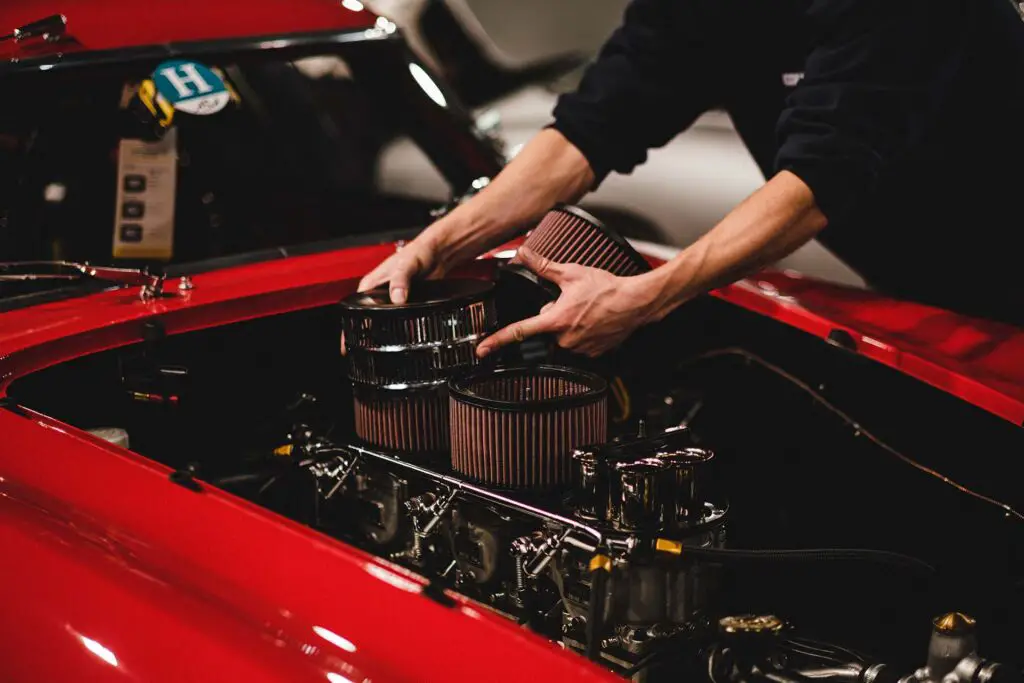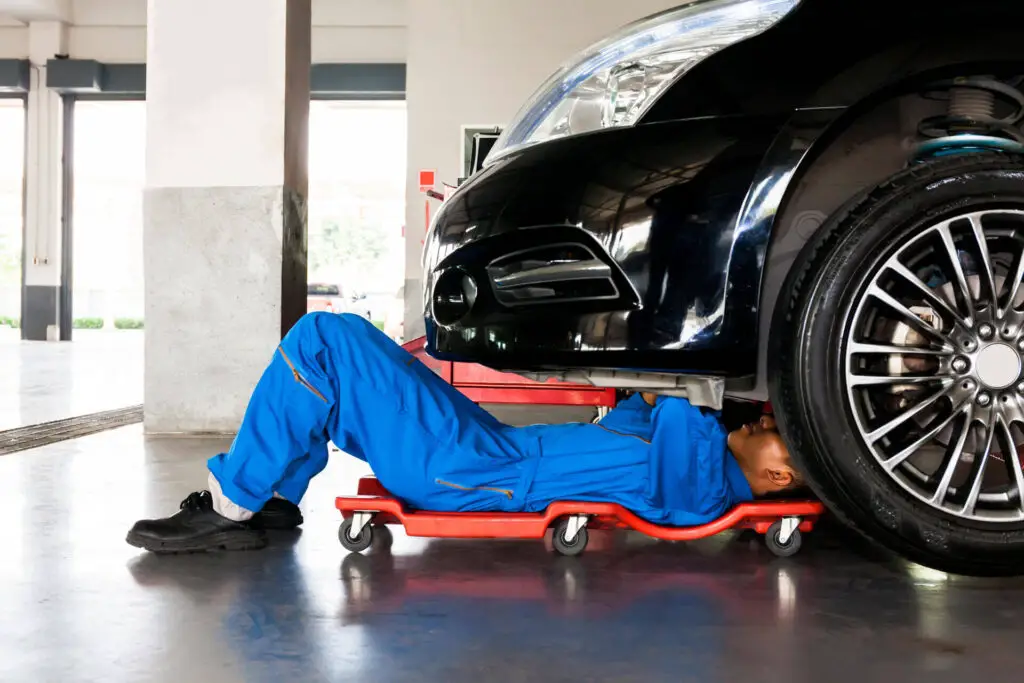Every car lover wants to maintain the performance of their beloved ride and strive for peak efficiency. If so, then it’s definitely worth learning about how to clean the air intake system. Pay attention to this part of vehicle maintenance, especially if you’re always on the hunt for ways to keep your machine running smoothly and looking great simultaneously. With some simple steps and a few basic tools, anyone can get their air intake system back up, spiffy, and function like never before!
To start with cleaning the air intake system, first remove the air filter and clean it or replace it if necessary. Next, use a specialized cleaner (I use CRC Mass Air Flow Sensor Cleaner) to remove any dirt, debris, or oil buildup from the intake manifold and throttle body. Be sure to also check and clean any sensors or valves. Finally, reassemble the air intake system and start the engine to ensure proper functioning.
What Is an Air Intake System?
An air intake system (AIS) is like a set of lungs for your vehicle’s engine. Just like our lungs bring in air to provide oxygen to our body, AIS brings in the air to provide oxygen to the engine. But it’s not just about oxygen – filters out harmful particles, such as dust and debris, to protect the engine from damage.
How Does It Work?
Think of it this way: your engine needs to breathe just like you do. If the air it breathes is dirty or contaminated, it can’t perform at its best. That’s why the AIS plays such an important role in your vehicle’s performance and lifespan. Here are some types of these systems.
| Air Intake System Type | Description |
| Cold Air Intake | A type of AIS that draws in colder air from outside of the engine bay to increase engine performance. Typically features a longer intake pipe and a high-flow air filter |
| Short Ram Intake | A type of AIS that features a shorter intake pipe than a cold air intake but still aims to increase airflow to the engine. Usually positioned within the engine bay |
| Ram Air Intake | A type of AIS that uses a series of ducts to force high-pressure air into the engine. Often used in high-performance vehicles |
| Stock Air Intake | The AIS comes standard with a vehicle from the factory. Designed for optimal engine performance and efficiency, but may not offer the same level of airflow as an aftermarket system |
| Performance Air Intake | An aftermarket AIS that is designed to increase airflow to the engine, resulting in improved performance. Can come in various shapes and sizes depending on the make and model of the vehicle |
Why Does It Need to Be Cleaned?
Just like you want to have the impeccable interior of your four-wheeler by polishing the steering wheel and having the headliner cleaned, ensuring that the vehicle’s engine is at its top-notch performance is also crucial.
This means you need to ensure the AIS is clean and functioning properly. That way, you’re giving your engine the best chance to thrive and perform at its highest level. So, next time you’re on the road, remember that your vehicle’s AIS is hard at work to keep your engine running smoothly.

What Are the Signs of a Dirty Air Intake System
Over time, the air filter and other components can become dirty and clogged, which can lead to a variety of problems. So, how can you tell if your AIS needs cleaning? Here are some signs to look out for – from decreased fuel efficiency to strange engine noises, your car might be giving you subtle hints that something is wrong with its lungs.
Don’t ignore these signs and learn to recognize them, as a dirty AIS can cause significant damage to your engine and even lead to costly repairs. This being said, let’s take a closer look at these signs.
Reduced Fuel Efficiency
One of the most common signs is reduced fuel efficiency. Although you’ll probably first test the fuel pressure regulator, keep in mind that a dirty AIS can lead to a decrease in airflow to the engine. As a result, this can cause the engine to work harder and use more fuel to maintain the same level of performance.
Poor Acceleration and Engine Performance
Another sign of a dirty AIS is poor acceleration and engine performance. This can be caused by a buildup of dirt and debris, which can restrict the amount of air that can reach the engine. As a result, your vehicle may struggle to accelerate or may feel sluggish when you press the gas pedal.
Dirty Air Filter
A dirty air filter is also a clear indication that your AIS needs attention. The air filter traps dirt, dust, and other contaminants before entering the engine. Over time, the filter can become clogged with these particles, which can cause a reduction in airflow and poor engine performance. If you notice that your air filter is visibly dirty or clogged, it’s time to clean or replace it (I use FRAM Extra Guard CA10755 for my four-wheeler).

How to Clean the Air Intake System a Step-by-Step Guide
The AIS is an essential component of your vehicle’s engine, responsible for supplying clean air to the combustion chamber. Over time, dirt, debris, and other contaminants can build up in the system, reducing its efficiency and causing engine performance issues. To prevent these problems and keep your engine running smoothly, it’s important to regularly clean your AIS. In this simple step-by-step guide, I’ll walk you through the whole process.
By following these straightforward steps, you can ensure that your AIS stays clean and operates efficiently, ultimately leading to better vehicle performance and a longer lifespan. It’s recommended to clean it at least annually or more often if you frequently drive in dusty or dirty environments.
Gather the Necessary Tools and Materials
To clean the AIS, you’ll need a few tools and materials, including a screwdriver, rags, a cleaning solution, and a new air filter if necessary. You’ll want to consult your owner’s manual to determine the appropriate cleaning solution and filter for your specific make and model.
Remove the Air Intake System
Start by locating the AIS in your vehicle’s engine bay. You may need to remove some plastic covers or other components to access it. Once you have access, use a screwdriver to loosen and remove any clamps or screws that are holding the AIS in place. Carefully disconnect any wires that are connected to it.
Clean the Air Intake System
With the AIS removed, you can begin cleaning it. Use a specialized cleaner to remove dirt from the intake manifold, throttle body, and other components. Be sure to also check and clean any sensors or valves. Use a rag to wipe away any excess cleaner and dirt.
Reinstall the Air Intake System
Once everything is clean, you can reinstall it in your vehicle. Reconnect any hoses or wires that were disconnected earlier and use a screwdriver to reattach any clamps or screws that were removed. Be sure to also replace the air filter if necessary. Once everything is in place, start the engine and ensure that it’s running smoothly.
Precautions and Tips for Cleaning the Air Intake System
Cleaning the AIS of your vehicle is an important maintenance task that can help improve engine performance and prolong the life of your vehicle. However, like any maintenance task, it’s important to take precautions and follow tips to ensure that the cleaning process is done safely and effectively.
Keep All the Safety Precautions in Mind
When cleaning the AIS of your vehicle, it’s crucial to prioritize safety. Here are some important safety precautions to keep in mind:
- Turn off the engine – Before beginning any work on your vehicle, be sure to turn off the engine and remove the key from the ignition.
- Wear protective gear – Use gloves, safety glasses, and a face mask to protect yourself from any chemicals or debris that may be released during the cleaning process.
- Work in a well-ventilated area – To avoid breathing in any harmful chemicals, work in a well-ventilated area or outdoors.
- Use the appropriate cleaning solution – Consult your owner’s manual to determine the appropriate cleaning solution for your specific make and model of vehicle. Using the wrong solution can cause damage.
- Follow instructions carefully – Read and follow the instructions on the cleaning solution carefully to ensure that you’re using it properly.
- Be gentle – When cleaning, be gentle and avoid using excessive force or pressure, as this can cause damage.
Check Out Some Tips for Effective Cleaning
In addition to taking safety precautions, there are some tips you can follow to ensure that your air intake system is effectively cleaned:
- Clean the air filter – Before cleaning, make sure to clean or replace the air filter, as a dirty filter can impede airflow and reduce engine performance.
- Use a specialized cleaning solution – Use a specialized cleaning solution that is designed for cleaning air intake systems. Avoid using harsh chemicals or degreasers that can do heavy damage.
- Be thorough – Clean all components thoroughly, including the intake manifold, throttle body, sensors, and valves. Use a rag or brush to remove any dirt or debris.
- Check for damage – While cleaning, inspect any signs of damage or wear, such as cracks or corrosion. If you notice any damage, consider replacing the affected components.
- Reinstall components correctly – When reinstalling the components, make sure to follow the manufacturer’s instructions carefully and ensure that all hoses, wires, and clamps are securely attached.
It may seem like a time-consuming process, but once you get your hands on all the right tools and actually fix something broken or malfunctioning on your vehicle, you’ll probably feel a sudden rush. And it’s completely normal! After all, you’ve done something you thought you would never do.

Cleaning the Air Intake System Will Keep Your Car Running Smoothly
Keeping your four-wheeler running smoothly and efficiently requires regular maintenance, and cleaning AIS is a relatively easy task that can help you do just that. Whether you choose to hire a professional or take care of this yourself, making sure your air intake system has a clean filter inside of it and no accumulated debris outside will ensure your engine runs optimally.
Not only can this improve fuel efficiency, but it can also enhance the longevity of several car components in the long run. Make sure to add this task to your preventative maintenance checklist so you don’t forget about it!








